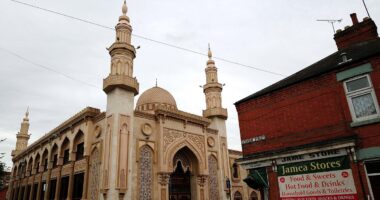THE US has carried out dozens of airstrikes across central Syria on terrorist ISIS targets, as Assad is overthrown by rebels.
More than 75 “precision airstrikes” were carried out on Sunday as fears over a power vacuum forming in the wartorn country grow.




President Joe Biden warned the toppling of Assad’s regime was a “moment of risk and uncertainty” for the Middle East.
Biden warned that ISIS would exploit the regime change in Syria and attempt to reestablish itself.
He said: “We will not let that happen.”
Biden confirmed the US would continue it’s involvement in the region to establish a transition “toward independent, sovereign and independent.”
Approximately 900 US troops are currently deployed in Syria, where they are working alongside Kurdish allies in the northeastern part of the country. Their main goal is to prevent the radical Islamist group from gaining control over the region.
Biden confirmed these troops would remain in the country as it conducted dozens of strikes in Syria.
Daniel Shapiro, a US government representative, has stated that the focus of American forces in Syria will be to eliminate the presence of the extremist organization. This was reported by NBC.
Shapiro expressed concerns about the unstable and constantly changing situation in Syria, warning that ISIS could take advantage of the turmoil to regroup and plan attacks beyond the country’s borders.
He added: “We’re determined to work with those partners to continue to degrade their capabilities.”
US President-elect Donald Trump shared very different beliefs to Biden on dealing with Syria and said he wants little to do with Assad’s departure.
In a post, he said: “This is not our fight… Let it play out. Do not get involved!”
The US Central Command said it was assessing damages from these strikes and said there were no indications of civilian casualties.
CENTCOM added: “The operation struck over 75 targets using multiple US Air Force assets, including B-52s, F-15s, and A-10s.”
ISIS had created a caliphate across large parts of Syria after the civil war broke out 13 years ago, and at one point controlled a third of the country.
It has since lost a majority of its land and control in the area.
Assad was ousted today after rebels led by Hayat Tahrir al-Sham, a group the US labelled a terrorist organisation, managed to overthrow the government in just 10 days.
Biden issued a stark warning against HTS, who has said it broke ties with al-Qaida a long time ago.
The US President said: “We will remain vigilant.
“Make no mistake, some of the rebel groups that took down Assad have their own grim record of terrorism and human rights abuses.”



The US has not been the only country to fire missiles into Syria as Israel launched rockets into Damascus on Sunday.
Security sources told Reuters that three Israeli airstrikes hit a Syrian government chemical weapon site in Damascus, said to have been used by Iran to develop missiles in the past.
One source said these strikes damaged infrastructure used to store military data, equipment, and guided missile parts.
Israel occupies a buffer zone in the Golan Heights, which was captured from Syria in 1967.
It comes after the IDF was deployed to the Golan buffer zone in preparation for chaos following the toppling of Assad, on Saturday night.
Israel confirmed that it also hit at least seven targets in southwest Syria on Sunday.
This included the Khalkhala air base where Israel claimed Assad’s troops abandoned missiles, air defence batteries, and munition.
The IDF’s chief of staff said it was now “fighting on four fronts,” which he said were Syria, Gaza, Lebanon, and Judea.
Assad fled Syria and reportedly flew with his family to Russia to claim asylum from his ally Vladimir Putin.
Russian state media reported the tyrant was granted the right to stay for “humanitarian reasons.”
The Russian Ministry of Foreign Affairs confirmed earlier today that humiliated Assad stepped down as president, fled the country, and begged for a “peaceful transfer” of power.
Despite this, Biden said on Sunday that he was not aware of Assad’s whereabouts and that the US was looking into reports he was in Russia.
A timeline of the Syrian civil war
The sudden collapse of Assad’s rule over Syria could mark the end of a nearly 14-year civil war in the country.
2011 – The first protests against Assad quickly spread across the country, and are met by security forces with a wave of arrests and shootings.
Some protesters take up guns and military units defect as the uprising becomes an armed revolt that will gain support from Western and Arab countries and Turkey.
2012 – A bombing in Damascus is the first by al Qaeda’s new Syrian affiliate, the Nusra Front, which gains in power and starts crushing groups with a nationalist ideology.
World powers meet in Geneva and agree on the need for a political transition, but their divisions on how to achieve it will foil years of U.N.-sponsored peace efforts.
Assad turns his air force on opposition strongholds, as rebels gain ground and the war escalates with massacres on both sides.
2013 – Lebanon’s Hezbollah helps Assad to victory at Qusayr, halting rebel momentum and showing the Iran-backed group’s growing role in the conflict.
Washington has declared chemical weapons use a red line, but a gas attack on rebel-held eastern Ghouta near Damascus kills scores of civilians without triggering a U.S. military response.
2014 – Islamic State group suddenly seizes Raqqa in the northeast and swathes more territory in Syria and Iraq.
Rebels in the Old City of Homs surrender, agreeing to move to an outer suburb – their first big defeat in a major urban area and a precursor to future “evacuation” deals.
Washington builds an anti-Islamic State coalition and starts air strikes, helping Kurdish forces turn the jihadist tide but creating friction with its ally Turkey.
2015 – With better cooperation and more arms from abroad, rebel groups gain more ground and seize northwestern Idlib, but Islamist militants are taking a bigger role.
Russia joins the war on Assad’s side with air strikes that turn the conflict against the rebels for years to come.
2016 – Alarmed by Kurdish advances on the border, Turkey launches an incursion with allied rebels, making a new zone of Turkish control.
The Syrian army and its allies defeat rebels in Aleppo, seen at the time as Assad’s biggest victory of the war.
The Nusra Front splits from al Qaeda and starts trying to present itself in a moderate light, adopting a series of new names and eventually settling on Hayat Tahrir al-Sham (HTS).
2017 – Israel acknowledges air strikes against Hezbollah in Syria, aiming to degrade the growing strength of Iran and its allies.
U.S.-backed, Kurdish-led forces defeat Islamic State in Raqqa. That offensive, and a rival one by the Syrian army, drive the jihadist group from nearly all its land.
2018 – The Syrian army recaptures eastern Ghouta, before quickly retaking the other insurgent enclaves in central Syria, and then the rebels’ southern bastion of Deraa.
2019 – Islamic State loses its last scrap of territory in Syria. The U.S. decides to keep some troops in the country to prevent attacks on its Kurdish allies.
2020 – Russia backs a government offensive that ends with a ceasefire with Turkey that freezes most front lines. Assad holds most territory and all main cities, appearing deeply entrenched. Rebels hold the northwest.
A Turkey-backed force holds a border strip. Kurdish-led forces control the northeast.
2023 – The Hamas attack on Israel on Oct. 7 triggers fighting between Israel and Hezbollah in Lebanon, ultimately reducing the group’s presence in Syria and fatally undermining Assad.
2024 – Rebels launch a new assault on Aleppo. With Assad’s allies focused elsewhere his army quickly collapses. Eight days after the fall of Aleppo the rebels have taken most major cities and enter Damascus, driving Assad from power.
Thesun.co.uk is your go-to destination for the best celebrity news, real-life stories, jaw-dropping pictures and must-see video.

















